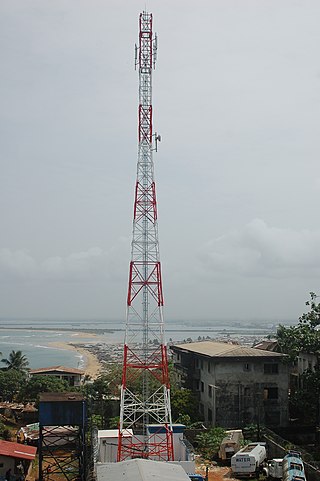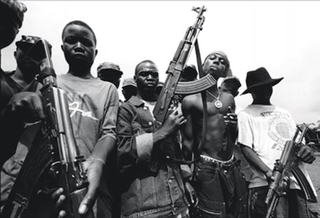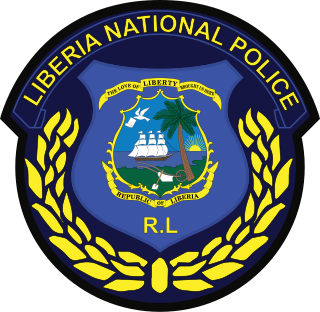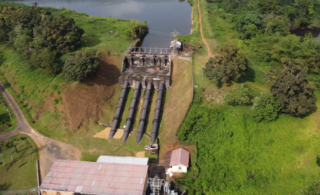Related Research Articles

Liberia, officially the Republic of Liberia, is a country on the West African coast. It is bordered by Sierra Leone to its northwest, Guinea to its north, Ivory Coast to its east, and the Atlantic Ocean to its south and southwest. It has a population of around 5 million and covers an area of 43,000 square miles (111,369 km2). The country's official language is English; however, over 20 indigenous languages are spoken, reflecting the country's ethnic and cultural diversity. The capital and largest city is Monrovia.

Liberia is a country in West Africa founded by free people of color from the United States. The emigration of African Americans, both free and recently emancipated, was funded and organized by the American Colonization Society (ACS). The mortality rate of these settlers was the highest among settlements reported with modern recordkeeping. Of the 4,571 emigrants who arrived in Liberia between 1820 and 1843, only 1,819 survived (39.8%).

The Politics of Liberia takes place in a framework of a presidential representative democratic republic modeled on the government of the United States, whereby the President is the head of state and head of government; unlike the United States, however, Liberia is a unitary state as opposed to a federation and has a pluriform multi-party system rather than the two-party system that characterizes US politics. Executive power is exercised by the government. Legislative power is vested in both the government and the two chambers of the legislature.
The economy of Liberia is extremely underdeveloped, with only $3.222 billion by gross domestic product as of 2019, largely due to the First (1989–1996) and Second Liberian Civil War (1999–2003). Liberia itself is one of the poorest and least developed countries in the world, according to the United Nations.

Mass media in Liberia include the press, radio, television, fixed and mobile telephones, and the Internet.

The president of the Republic of Liberia is the head of state and government of Liberia. The president serves as the leader of the executive branch and as commander-in-chief of the Armed Forces of Liberia.

Monrovia is the capital city of the West African country of Liberia. Founded in 1822, it is located on Cape Mesurado on the Atlantic coast and as of the 2008 census had 1,010,970 residents, home to 29% of Liberia’s total population. As the nation's primate city, Monrovia is the country's economic, financial and cultural center; its economy is primarily centered on its harbor and its role as the seat of Liberian government.

The culture of Liberia reflects this nation's diverse ethnicities and long history. Liberia is located in West Africa on the Atlantic Coast.
Whig or Whigs may refer to:

The First Liberian Civil War was the first in a series of two civil wars within the West African nation of Liberia. It lasted from 1989 to 1997. President Samuel Doe had established a regime in 1980 but totalitarianism and corruption led to unpopularity and the withdrawal of support from the United States by the late 1980s. The National Patriotic Front of Liberia (NPFL) led by Charles Taylor invaded Liberia from the Ivory Coast to overthrow Doe in December 1989 and gained control over most of the country within a year. Doe was captured and executed by the Independent National Patriotic Front of Liberia (INPFL), a splinter faction of the NPFL led by Prince Johnson, in September 1990. The NPFL and INPFL fought each other for control of the capital city, Monrovia and against the Armed Forces of Liberia and pro-Doe United Liberation Movement of Liberia for Democracy. Peace negotiations and foreign involvement led to a ceasefire in 1995 but fighting continued until a peace agreement between the main factions occurred in August 1996. Taylor was elected President of Liberia following the 1997 Liberian general election and entered office in August of the same year.

The Second Liberian Civil War was a civil war in the West African nation of Liberia that lasted from 1999 to 2003.

General elections were held in Liberia on 15 October 1985. They were the first elections since the 12 April 1980 military coup that brought Samuel Doe to power. During 1984, a new draft constitutional was approved in a referendum, which provided for a 58-member civilian and military Interim National Assembly, headed by Samuel Doe as president. After a ban on political parties was lifted, four parties – Doe's National Democratic Party (NDP), the Liberian Action Party, the Unity Party and the Liberia Unification Party – contested the elections.

The Liberian National Police is the national police force in Liberia. The LNP's mandate is:

The Firestone hydroelectric power station is a hydroelectric power station in Liberia on the Farmington River. Built in 1942, it was the first power generating dam built in the country. Located in Harbel, Margibi County, it is operated by the Firestone Plantations Company.

Railways in Liberia comprised two lines from the port of Monrovia in the northeast, and one line from the port of Buchanan in the centre. The lines were built principally to transport iron ore. By 2010, only the Bong mine railway was operational but the Lamco Railway was rebuilt by Arcelor Mittal and put back into service in 2011 as far as Tokadeh, Nimba County, allowing export of iron ore from the company's mine on the Guinean border via the Port of Buchanan.

Visitors to Liberia must obtain a visa from one of the Liberian diplomatic missions unless they come from one of the visa exempt countries. Yellow fever vaccination is required.
Formal electricity services are solely provided by the state-owned Liberia Electricity Corporation, which operates a small grid almost exclusively in the Greater Monrovia District. The vast majority of electric energy services is provided by small privately owned generators. At $0.54 per kWh, the electricity tariff in Liberia is among the highest in the world. Total installed capacity in 2013 was 20 MW, a sharp decline from a peak of 191 MW in 1989.

The MV Karadeniz Powership İrem Sultan is a Liberia-flagged Powership, a floating power plant, owned and operated by Karpowership. Built in 1984 by the Fincantieri Marghera Shipyard in Venice, Italy and christened MV Nikolay Markin, she sailed as a barge carrier under various names and flags until in 2014 she was converted into a powership at the Sedef Shipyard in Tuzla, Istanbul, Turkey. She served in Nacala, Mozambique supplying electricity to Mozambique's power grid for land-locked Zambia. Currently, she serves in the dominican Republic and is stationed in Santo Domingo.

The 1980 Liberian coup d'état happened on April 12, 1980, when President William Tolbert was overthrown and murdered in a violent coup. The coup was staged by an indigenous Liberian faction of the Armed Forces of Liberia (AFL) under the command of Master Sergeant Samuel Doe. Following a period of transition, Doe ruled Liberia throughout the 1980s until his murder in 1990 during the First Liberian Civil War.

Americo-Liberian people, are a Liberian ethnic group of African American, Afro-Caribbean, and liberated African descent. The sister ethnic group of Americo-Liberians are the Sierra Leone Creole people, who share similar ancestry and related culture. Americo-Liberians trace their ancestry to free-born and formerly enslaved African Americans who emigrated in the 19th century to become the founders of the state of Liberia. They identified there as Americo-Liberians. Some African Americans following resettlement in Canada also participated as founding settlers in Sierra Leone and other Recaptive repatriates settled in present-day Côte d'Ivoire.
References
- ↑ "LEC Completes 18 Megawatt Power Plant | The Liberian Observer". www.liberianobserver.com. Archived from the original on 2016-05-31.